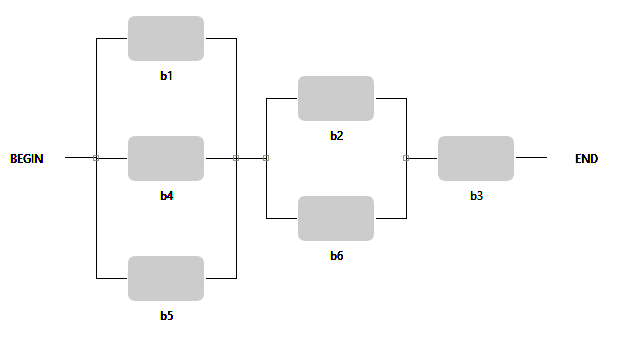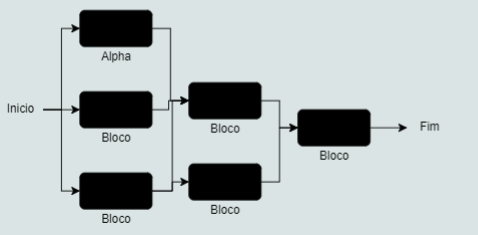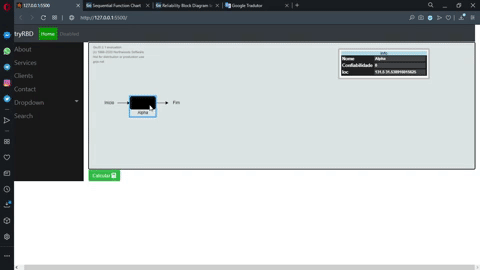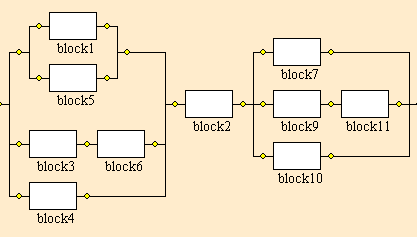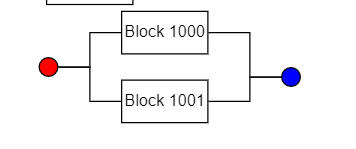Here is one possible solution, assuming you don’t need to nest:
<!DOCTYPE html>
<html>
<head>
<title>Minimal GoJS Sample</title>
<!-- Copyright 1998-2020 by Northwoods Software Corporation. -->
<meta charset="UTF-8">
<script src="go.js"></script>
<script id="code">
function init() {
var $ = go.GraphObject.make;
myDiagram =
$(go.Diagram, "myDiagramDiv",
{
isReadOnly: true,
layout: $(go.TreeLayout, { layerSpacing: 20 })
});
myDiagram.nodeTemplate =
$(go.Node, "Spot",
{ selectionObjectName: "BODY" },
$(go.Panel, "Auto",
{ name: "BODY", width: 80, height: 35 },
$(go.Shape,
{ fill: "white" },
new go.Binding("fill", "color")),
$(go.TextBlock,
new go.Binding("text"))
),
// in place of links connecting with each node
$(go.Shape, "LineH", { alignment: go.Spot.Left, alignmentFocus: go.Spot.Right, width: 10, height: 0 }),
$(go.Shape, "LineH", { alignment: go.Spot.Right, alignmentFocus: go.Spot.Left, width: 10, height: 0 })
);
myDiagram.nodeTemplateMap.add("Split",
$(go.Node,
{ locationSpot: go.Spot.Center },
$(go.Shape, "Circle",
{ fill: "white", desiredSize: new go.Size(6, 6) })
));
myDiagram.nodeTemplateMap.add("Merge",
$(go.Node,
{ locationSpot: go.Spot.Center },
$(go.Shape, "Circle",
{ desiredSize: new go.Size(6, 6) })
));
myDiagram.linkTemplate =
$(go.Link,
{ selectable: false, routing: go.Link.Orthogonal },
$(go.Shape)
);
// define the Group template to be fairly simple
myDiagram.groupTemplate =
$(go.Group, "Auto",
{ layout: $(go.GridLayout, { wrappingColumn: 1, cellSize: new go.Size(1, 1) }) },
$(go.Shape, { fill: "transparent" }), // draws vertical segments as if links connecting each node
$(go.Placeholder, { padding: new go.Margin(-17.5, 0) }) // half the node height
);
myDiagram.model = new go.GraphLinksModel(
[
{ key: 0, category: "Split" },
{ key: 9999, category: "Merge" },
{ key: -1, isGroup: true },
{ key: 10, text: "Alpha 1", color: "lightblue", group: -1 },
{ key: 11, text: "Alpha 2", color: "lightblue", group: -1 },
{ key: 12, text: "Alpha 3", color: "lightblue", group: -1 },
{ key: -2, isGroup: true },
{ key: 20, text: "Beta 1", color: "orange", group: -2 },
{ key: 21, text: "Beta 2", color: "orange", group: -2 },
{ key: -3, isGroup: true },
{ key: 30, text: "Gamma", color: "lightgreen", group: -3 },
{ key: -4, isGroup: true },
{ key: 40, text: "Delta 1", color: "pink", group: -4 },
{ key: 41, text: "Delta 2", color: "pink", group: -4 }
],
[
{ from: 0, to: -1, },
{ from: -1, to: -2 },
{ from: -2, to: -3 },
{ from: -3, to: -4 },
{ from: -4, to: 9999 }
]);
}
</script>
</head>
<body onload="init()">
<div id="myDiagramDiv" style="border: solid 1px black; width:100%; height:600px"></div>
</body>
</html>
The result:
The idea for the model is that you just need to define a bunch of groups, basically one per “column”, and you define the relationships between the groups so that you get the ordering that you want.
I suppose the “Split” and “Merge” (a.k.a. “Begin” and “End”) nodes don’t need to be part of the model – they could be added whenever one loads a model.
